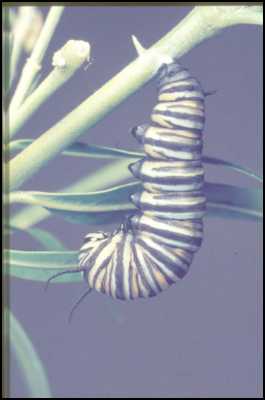Help At Hand For Starving Monarchs

A caterpillar in the hanging "J" shape it assumes just before it changes to a pupa, or chrysalis.
Landcare Research has helpful advice for monarch butterfly enthusiasts, who are concerned that their ravenous caterpillars have stripped swan plants, and may not survive to chrysalis stage.
Scientists believe that monarch butterflies (Danaus plexippus) are self introduced into New Zealand. Earliest records of them date back to the 1880s, though their favourite food, the swan plant (Gomphocarpus fruticosus) was introduced some time later. Because monarch caterpillars eat only introduced plants, they have no harmful effects on the New Zealand ecosystem.
Landcare Research entomologist Leonie Clunie says she receives many calls at this time of year from people wanting to know how to save their starving caterpillars. Mrs Clunie says there are alternative sources of food, though none are ideal.
"One option is simply to transfer the caterpillars onto a slice of pumpkin. However, this is not the best food for them, and though it may tide the bigger ones over, the younger ones won't survive.
"The same applies to tweedia (Oxypetalum caeruleum), a popular garden plant with a small blue flower, and to moth plant (Araujia sericifera), which is a weed".
Chris Winks, a Landcare Research entomologist, says though monarch butterfly caterpillars will develop successfully on moth plant, eggs are generally not laid on it. Moth plant is also known as 'cruel plant', bringing both life and death to the monarch. Though it provides nutrients to caterpillars, the flowers trap the mouthparts of feeding butterflies, inflicting a slow death from exhaustion and dehydration.
Despite such casualties of both adults and starving caterpillars, monarchs will remain a colourful presence in New Zealand. "It is part of the monarchs' survival strategy to produce large numbers of caterpillars, many of which will die" says Leonie Clunie. "Therefore, monarch lovers need not be too distressed".
Also, some of the strugglers may end up to be the longest-lived. "Most of the monarch butterflies around at the height of summer live for about two weeks. But the caterpillars that reach chrysalis stage late in the season could emerge as the butterflies that hibernate through the winter, and produce more caterpillars the next summer".
ENDS/
For more information, contact: Mrs Leonie Clunie Mr Chris Winks Landcare Research Mount Albert Research Centre Auckland ph. (09) 815 4200 e-mail: ClunieL@landcare.cri.nz WinksC@landcare.cri.nz


 University of Auckland: Protecting Young Minds With AI
University of Auckland: Protecting Young Minds With AI Greenpeace: Greenpeace Calls On Fonterra Investors To Consider Big Picture With Giant Puzzle
Greenpeace: Greenpeace Calls On Fonterra Investors To Consider Big Picture With Giant Puzzle Hugh Grant: How New Tech Helps Kids Love Soccer More
Hugh Grant: How New Tech Helps Kids Love Soccer More Bill Bennett: Download Weekly - 100% claim lands One New Zealand in criminal court action
Bill Bennett: Download Weekly - 100% claim lands One New Zealand in criminal court action FSCL: Woman Scammed Out Of $25,000 After Job Offer On LinkedIn
FSCL: Woman Scammed Out Of $25,000 After Job Offer On LinkedIn NIWA: Cheers To Crustaceans - New Species Named After Welly Brewery
NIWA: Cheers To Crustaceans - New Species Named After Welly Brewery



